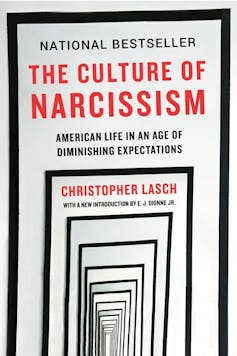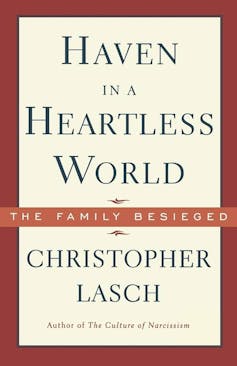Nick Haslam, The University of Melbourne
A cultural critic rails against a society that worships celebrity and prizes images over ideas. A progressive intellectual attacks the dominance of corporate elites. A curmudgeonly academic condemns his society’s ignorance of its past and the dumbing down of public education. A psychologically astute writer explores the conflicts eddying around gender and sexuality.
Who are these disparate thinkers, you ask? Not four contemporary pundits, but a single controversialist, writing almost half a century ago.
The American historian Christopher Lasch, who died in 1994, authored a series of books that established him as one of his nation’s leading public intellectuals. The most influential of these, first published in 1979, was The Culture of Narcissism: American Life in An Age of Diminishing Expectations.
This blockbuster earned Lasch audiences with President Jimmy Carter, a National Book Award, and a spread in People magazine, where he shared top billing with Olivia Newton-John. The book was contentious in its time, drawing flak from feminists and Lasch’s erstwhile friends on the Left. It received qualified support from some conservatives, who were otherwise antagonistic to his anti-capitalist principles. Reissued in 2018, this important work warrants a new look.
The Culture of Narcissism’s era now seems very distant. The Vietnam War had ended in American failure only four years earlier. Carter’s presidency was lurching toward its own failure in the midst of an energy crisis, soaring inflation and Cold War tensions. The Reagan revolution was yet to take the nation rightwards. A spirit of decline prevailed as the nation’s pride, confidence and optimism were under threat.
The United States was in the grip of a narcissistic culture, a malign transformation of its individualist traditions. Whereas the individualist aspired to the Protestant virtues of self-reliance and self-discipline, the narcissist was self-absorbed and self-indulgent, seeking shallow sociability, pleasure and packaged self-awareness. Modern narcissists have a therapeutic sensibility, Lasch argued, seeing mental health as “the modern equivalent of salvation,” but they feel empty and inauthentic.
Narcissism can mean many things, and Lasch was at pains to distinguish his understanding from popular alternatives. In an afterword written in 1990, he dismissed the idea that narcissism is a synonym for selfishness or that his book was just another critique of the 1970s as the “me decade”.
Laschian narcissism is not, he says, a moralistic concept for savaging the failings of a society or generation, nor is it another word for arrogance.
Narcissism should instead be understood within a psychoanalytic framework. It is embodied not only in anxiously preening individuals, but in the institutions that produce and nurture them. Following Freud and leading American analysts of his time, Lasch views narcissism as a condition of grandiosity and inner emptiness, in which the person sees the world as their mirror. Narcissism reveals itself in compulsive self-surveillance and fantasies of fame, power and beauty. Its dark side is repressed rage and envy and a tendency to engage in superficial and exploitative relationships.
Lasch equivocated on the extent of this new narcissism. Arguing “every age develops its own peculiar forms of pathology”, he asserted that candidates for psychotherapy in the 1970s no longer complained of traditional neuroses, with their alienated obsessions and phobias. Instead, they presented with disorders of the self. He proposed that many high profile public figures were narcissists, but backs off the claim that narcissistic personalities were more prevalent in the general population than in earlier times.
Lasch saw the reverberations of narcissism throughout American life. Most of his book offers a critical analysis of the manifestations of a narcissistic culture in several domains.
Family, sex, education, ageing
Reflecting the preoccupations of his previous book, Haven in a Heartless World (1977), Lasch sees the traditional family as the endangered foundation of society. Under pressure from hedonistic cultural trends and mass consumption, parenting has become indulgent. Mothers and fathers abdicate their authority to child rearing fads, the state, and the therapeutic professions. Authority itself has been discredited, although hierarchies remain as strong as ever in “a society dominated by corporate elites with an anti-elitist ideology”.
Lasch’s critique of the “appropriation of parental functions” by therapeutic institutions is part of a broader denunciation of a “new paternalism”. He sees a troubling rise in the popular use of therapeutic jargon and in the regulation of private and public behaviour by helping and welfare professions.
There is a gentle irony in Lasch’s use of the concept of narcissism to criticise the “popularization of psychiatric modes of thought” in American society, but his fundamental concern is that understanding deviance as illness erodes self-reliance and personal responsibility.
Lasch’s account of the effects of a narcissistic culture on relations between the sexes is equally pessimistic. It trivialises close relationships and undermines marriage, as women and men flee deep emotional entanglements in search of less demanding forms of connection.
The decline of traditional gender roles brings with it an intensified “sexual warfare” of mutual resentment. Lasch sees feminism as a contributing current in these developments, “often mak[ing] women more shrewish than ever in their daily encounters with men”. In a not entirely convincing show of balance, he also skewers men’s “deeply irrational” feelings of being imperilled by changing gender arrangements.
Mass education is another of Lasch’s targets, excoriated for creating a “spread of stupidity”, an “atrophy of competence” and “new forms of illiteracy”. A progressive might be expected to celebrate the expansion of access to higher education, but Lasch sees a wholesale lowering of standards and a rising ignorance of history, literature and civics. Meanwhile, universities are plagued by grade inflation, commodified degrees, swollen administrative bureaucracies and cafeteria-style curricula.
Behind these grim developments, Lasch sees a decline in the social value placed on personal achievement, a narrow emphasis on relevance and the vocational mission of higher education, and an anti-elitism that erodes the quality and ambitions of education across the spectrum, from community colleges to the Ivy League.
Narcissistic culture also reveals itself in shifting views of ageing. Lasch bemoans a rising “cult of youth” and a dread of getting old, expressed in obsessions with physical appearance and desperate striving for longevity.
Behind this panic is a more basic “cult of the self”. Narcissistic adults cling to the illusion of youth because they are over-invested in personal image and appearance and feel no connection to a future beyond their lifespan.
Lasch is an avid collector of cults: his book also proclaims cults of authenticity, celebrity, compulsive industry, consumption, expanded consciousness, friendliness, intimacy, growth, lost innocence, pragmatism, privatism, self-culture, sincerity, sports, the strenuous life, teamwork, victory and womanhood.
The book’s legacy
In an introduction to the 2018 edition, the political commentator E.J. Dionne writes that “The Culture of Narcissism seems to leap across the decades” carrying enduring truths for our time. Just how prescient it was – how much it leaps rather than stumbles – is a matter for debate. The book sounds an early warning for several trends that have endured and intensified, but in other respects it seems dated.
One dated feature is the book’s heavy reliance on psychoanalytic ideas. Outside of small remnant communities of analysts, it is now profoundly unusual to see Freudian jargon littered so freely and unapologetically through works of social criticism, or to come across references to castrating mothers. Lasch wrote at a time when the cultural prominence of psychoanalysis in the literary Anglosphere had reached its peak, only to fall off a cliff in the 1990s.
Intellectual fashions come and go, of course – Norman Mailer and Kurt Vonnegut are no longer literary icons either – but sections of The Culture of Narcissism now speak an almost foreign language, occasionally peddling arrant psychoanalytic nonsense, such as the familial origins and narcissistic basis of schizophrenia.
The Culture of Narcissism’s positions on sex and gender now seem reactionary and almost quaint. The conflicts Lasch examines continue in struggles over gender inequality and sexual violence, and in the manosphere backlash, but few would see them as being in a state of crisis: more a constant low hum of ongoing friction than signs of impending disaster. The idea that feminism has turned women shrewish now seems risible, emanating from a time when inequality at work and in the home still appeared to be the natural state of affairs.
Lasch’s critical remarks on mass education also seem retrograde, especially coming from a time when participation in higher education was much lower and more limited to a social elite than it is today. The proportion of Americans with college degrees is now well over double the proportion in 1979, when it was below one in six.
The declinist view that educational standards are slipping long preceded Lasch’s critique. It persists to this day around the globe, often in reaction to broadened access. With the complaint being so generalised across time and space, it seems questionable to attribute a decline specifically to rampant narcissism in 1970s America, especially as the excellence and scale of the nation’s universities were the envy of the world at the time.
But Lasch was surely correct in identifying narcissism as a major American cultural trend before others had made the connection. Narcissism is now a vastly more popular concept in everyday discourse than it was in 1979. It has become the focus of an enormous psychological literature. Repeated surveys of young Americans have demonstrated steadily rising levels of the trait, and it is indispensable in making sense of public figures, recent presidents included.
Equally precocious is Lasch’s emphasis on the rise of images in the social world. His language is anachronistic, but his sentiment resonates in this digital age:
Cameras and recording machines not only transcribe experience but alter its quality, giving to much of modern life the character of an enormous echo chamber, a hall of mirrors.
Lasch could not have foreseen how social media and the internet would saturate us with alluring images, amplify our narcissistic concerns with appearance and self-curation, and foster the shallow and diffuse social relationships and obsession with youth that his book condemned.
More generally, The Culture of Narcissism’s critique of the then new therapeutic mindset rings even truer today. Lasch offered an early diagnosis of the prevailing tendency to frame problems of meaning in psychiatric terms and to identify mental health with personal authenticity.
At a time when therapy-speak is rife, when concepts of mental ill-health continue to expand, and when “authentic” has been crowned as 2023’s word of the year, it is clear Lasch’s book foretold a psychologised future.
The Culture of Narcissism is a product of its time: what book is not? Even so, it remains an important work of criticism. Whether its central concept can bear the explanatory weight Lasch loads upon it can be queried, but narcissism serves as a novel point of attack on an ambitious range of cultural targets. In this regard, the book still deserves to be read.
In our polarised times, readers might also appreciate a work of criticism that resists political categorisation. Lasch is radical on some issues, but socially conservative on others. He is fierce in his attack on corporate elites, but unabashed in his cultural elitism. He is critical of feminism, but bracing in his attack on male insecurity. He is favourable towards restoring authority and the traditional family, but keen to build new local “communities of competence”.
Lasch’s voice is usually sharp-tongued and dyspeptic – he is against much more than he is for – but it is always interesting.
Nick Haslam, Professor of Psychology, The University of Melbourne
This article is republished from The Conversation under a Creative Commons license. Read the original article.
Images by StarryAI in the style of Andy Warhol.










